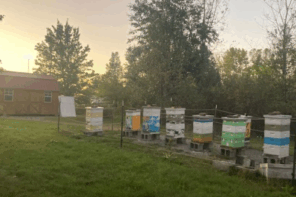The Diagnosis of the Shrew
Dr. Tracy Farone
One thing about beekeeping is it always provides an opportunity to learn something new. It definitely keeps one humble trying to keep up with new (while remembering the old) information. In a recent conversation with a few Honey Bee Veterinary Consortium colleagues, one member was trying to figure out a sudden early Spring collapse of a single hive located in Iowa. The main evidence was a large pile of dead bees that looked chewed up with the thoraxes apparently hollowed out (see photos 1 and 2). Long story short, the conclusion was made that pygmy shrews were the main culprit. Pygmy shrews… hmmm. I vaguely remember reading about them as a pest in Canada, but they really were not on my radar as a common differential for a cause of a weak colony coming out of Winter and/or colony collapse. Turns out they are a common pest to add to the list in the U.S., particularly northern States. In my research of this pesky mammal, I found that many beekeepers may be unaware of this pest, so I thought I would devote an article to help bring more awareness to this little creature.
Pygmy shrew (Sorex hoyi) fast facts
- Common names used: Northern or American pygmy shrew.
- Sorex minutus is not the same shrew but found in Europe and Asia.
- Very small; smallest American mammal by weight with an average of three grams.
- Can fit through a hole less than one centimeter- so typical mouse guards will not keep them out.
- Pointy snout with whiskers.
- Have a tail almost as long as their 1½-inch body.
- Grey in color.
- Eats primarily insects and arachnids.
- Take bees from the outside of the cluster and then consume the bulk of the thorax containing the delicious meatball of flight muscles.
- Fast moving, so they are hard to catch a glimpse of…
Clinical Findings in a Colony
- Pile of dead bees, bodies macerated, thoraxes eaten or hollowed out.
- A more common reason for decapitated bees (If you are in Washington state area, it is very likely Asian hornets are the cause of decapitation).
- Shrew droppings may be found – they look similar but are somewhat different compared to mice droppings.
- Finding a dead shrew in a hive is the only 100% way to confirm a diagnosis.
- Shrews do not eat honey/pollen. Stores will be left undisturbed unlike mice infestations.
- Seasonality: active bees keep shrews away, so shrews are a Winter and early Spring issue.
Typically, only one or a few hives are affected. This may not be important for a larger operation but if you only have one backyard hive the results could be devastating. The literature reports that in Canada the shrews have adapted to invading hives in the Winter as a survival strategy, so some Canadian commercial operations unfortunately have had considerable losses due to pygmy shrews.
Prevention or Remedies?
Assessing your risk for pygmy shrew invasion is up to you, whether it is worth it for you and your operation to apply preventative remedies or not. Wire mesh can be applied going into Winter at hive entrances. Recommendations range from one quarter to three eighth of an inch. Such small entrances are harder for bees to get into the hive especially with pollen loads, but the three eighths of an inch mesh may be more forgiving for honey bees to enter the hive with pollen. Beekeepers may choose to apply the mesh only in the late Fall and remove it in the Spring. Again, it is a risk verses labor cost assessment for beekeepers to consider but it is something else to keep an eye out for now that you know the signs.
References and for Additional Information
https://beeinformed.org/2014/04/18/the-pygmy-shrew-a-little-mammal-that-is-causing-big-problems-in-canadian-overwintering-colonies/
http://www.nbba.ca/wp-content/uploads/2014/03/shrew_screen.pdf
https://www.michiganbees.org/northern-shrew-and-bee-hives/
https://www.honeybeesuite.com/blaming-shrew/
https://animaldiversity.org/accounts/Sorex_hoyi/
Study Hall. Question on pygmy shrews answered by Jerry Hayes, ed., Bee Culture, April 2022, pg.14.
Photo credits: Gracious thanks to Dr. Kristen Obbink, DVM













